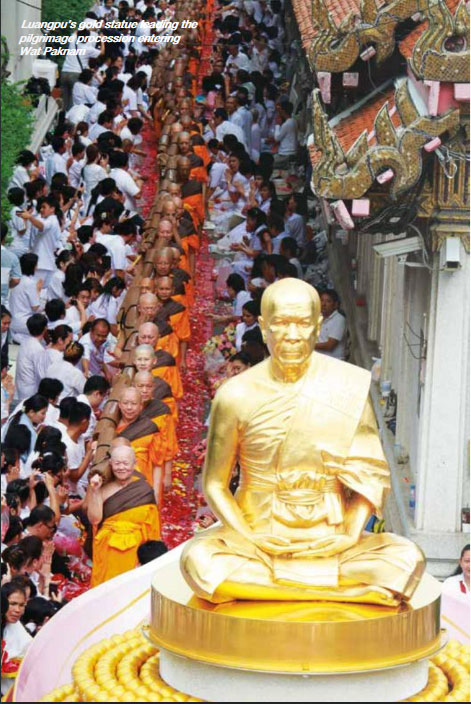
Luangpu Wat Paknam, the Great Master Phramongkolthepmuni, is one of Thailand's most revered Buddhist monks in history. His teachings have changed the lives of millions.
It is not an everyday event that a Great Master like Phramongkolthepmuni comes into this world, whose spiritual insight, wisdom and teachings have helped so many. People from around the world, whose lives have been touched by Luangpu's wisdom and teachings, have come together to create gold statutes bearing his image in order to commemorate his great virtues and contribution to mankind. Seven of these gold statues have so far been cast, six of which are enshrined at six different locations in Thailand that represent important places of the Great Master's life:
1. Lotus Land, Suphanburi - Luangpu's birth place
2. Wat Songpinong, Suphanburi - Place of ordination
3. Wat Bote-bon, Bangkuvieng, Nonthaburi - Dhammakaya attainment site
4. Wat Bang-pla, Nakorn Pathom - First Dhammakaya propagation site
5. Wat Paknam Bhasicharoen, Bangkok - Luangpu's home base
6. Wat Phra Dhammakaya, Pathumthani - World center for Dhammakaya propagation
1. LUANGPU'S BIRTH PLACE
Lotus Land, Suphanburi, Home of the Memorial Hall of Phramongkolthepmuni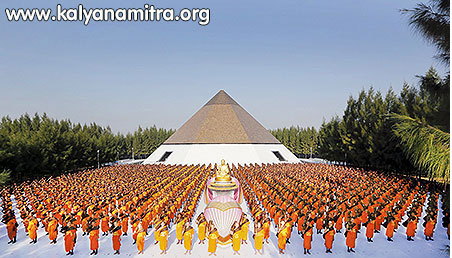
Luangpu Wat Paknam was born in 1884 in the Songpinong District of Suphanburi Province on a land uniquely resembling two lotus buds-thus the name 'Lotus Land', as it is known. Lotus Land is approximately eight acres in size, surrounded by water. It sits opposite of Wat Songpinong where Luangpu began his elementary education at the age of nine.
The Memorial Hall was built on this land. It has the feature of an octagonal mountain of gold and contains the chronicles of Luangpu's pursuit of Perfections from youth until the final periods of his life. A solid gold statue of Luangpu is enshrined inside at the center of the Memorial Hall where laypeople can come to pay respect and be inspired by his remarkable virtues.
2. PLACE OF ORDINATION
Wat Songpinong, Suphanburi
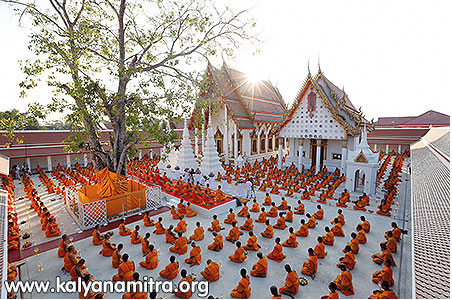
Wat Songpinong in Suphanburi Province marked the monastic beginning of Luangpu as a Buddhist monk. Luangpu was ordained at Wat Songpinong in July 1906 when he was twenty-two years old. His monastic name was "Candasaro Bhikkhu".
Wat Songpinong is an ancient temple from the Ayutthaya period, built around 1669 during the reign of King Narai. Today, it is an archetype of a well-developed local temple. The name "Songpinong" derives from the legend of two elephant siblings that were said to have walked out from Poo-muang Forest in U-Thong District where the king's herd of elephants inhab ited. During the dry season, these elephants often roamed nearby in search of food. The persistent journeys made by these huge creatures eventually transformed the path into a channel known today as "Songpinong Canal".
3. DHAMMAKAYA ATTAINMENT SITE
Wat Bote-bon, Bangkuvieng, Nonthaburi
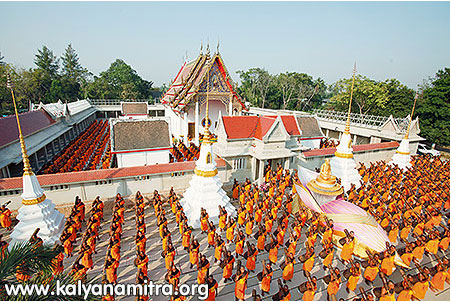
Wat Bote-bon rests on the west bank of Bangkok-Noi Canal in Bangkuvieng, Nonthaburi Province. Although it is an older temple built towards the end of the Ayutthaya period, Wat Bote-bon is a well-preserved historic monument attesting to the superb artistry and skills of Thai craftsmen of the past. The temple's history is not clear, but the book Temples in the Kingdom, 2nd Edition (published in 1983) cites that "... the king during the Ayutthaya era once resided in the vicinity where the temple is located. The king later commissioned for the construction of a permanent landmark that characterized the artistic styles of the Ayutthaya period. Its unique feature is the main chapel constructed in the shape of a sailing vessel to represent the travel and trade of the past." Wat Bote-bon is presumed to have been built around 1757 and subsequently designated a consecrated boundary and granted to the Sangha Community by the monarch in 1767.
The 15th day of the 10th waxing moon in 1917 marked a turning point in Luangpu's life. It was the eleventh year of his monkhood. He reflected on the fact that he had been ordained for eleven years and had never missed a day of Dhamma study and meditation practice, still he had yet to attain the Truth realized by the Lord Buddha. That day, he determined to put forth all his energy to meditation until he attained even a small portion of the Truth. After having finished his daily chores, he proceeded to the main chapel of Wat Bote-bon to meditate. Sitting in the half lotus position in front of the main Buddha statue at the shrine hall, he made the following resolution:
"Upon this sitting, if I cannot attain even a small part of the ultimate Dhamma realized by the Lord Buddha, then I shall sit unmoved in this spot ... or die in the attempt."
After several hours of deep concentration, Luangpu's mind finally came to a perfect stand-still. Going yet deeper he could see the transcendental nature of himself-a crystal clear "astral body" that resides within every human being. As his mind continued to be perfectly calm and still, several transcendental bodies appeared, one after another, each new one bigger, brighter, and more beautiful than the previous one. Until, finally, a supremely bright and pure image resembling that of the Buddha appeared. It is of the form of the Buddha sitting deep in meditation, the crest of his crown shaped like a lotus bud-an image brighter, clearer, more beautiful, and more marvelous than any Buddha image in the world. This was 'Dhammakaya'-Body of Enlightenment.
It was here at Wat Bote-bon that Luangpu reached the highest state of meditative attainment known as 'attaining Dhammakaya'.
4. FIRST DHAMMAKAYA PROPAGATION SITE
Wat Bang-pla, Nakom Pathom
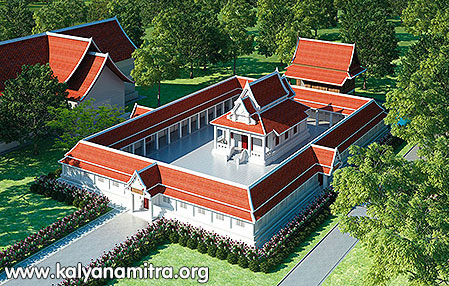
Wat Bang-pla is a community temple of the Maha Nikaya Order in the Theravada tradition located in Bang-lane District of Nakorn Pathom Province. It is an ancient temple presumed to have been constructed before the Rattanakosin period of Bangkok. This presumption is based on architectural similarities found in structures from the late Ayutthaya to early Rat tanakosin periods, and also from a poem by a royal poet known as Sunthornphu. Since the temple lies adjacent to the Nakornchaisi River and the mouth of Bang-pla Canal, locals commonly referred to it as 'Wat Bang-pla', a name that has endured to this day.

After having attained Dhammakaya at Wat Bote-bon, Luangpu foresaw in his meditation that several individuals from Wat Bang-pla would attain Dhammakaya following his footsteps. He subsequently took residence at Wat Bang-pla and taught meditation there. Four months later, three monks and four laypeople attained Dhammakaya.
5. LUANGPU'S HOME BASE
Wat Paknam Bhasicharoen, Bangkok
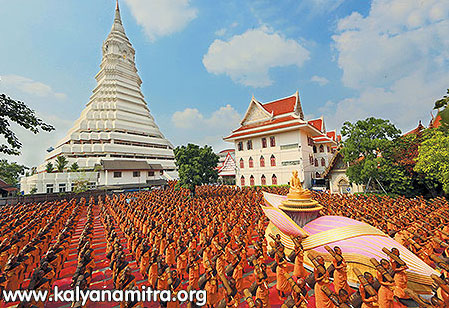
Classified as a royal temple of the third tier, Wat Paknam is an older temple commissioned for construction by the monarch during the middle Ayutthaya period (1488-1629). Historic chronicles and artifacts found at the temple, especially the architectural style and arts like the Tipitaka Hall and the pavilion-shaped cabinet housing the Tipitaka, are works of royal craftsmen from the era of King Narai; even the main chapel is representative of the style from that period.
Wat Paknam is located on flat delta plains of Bangkok, surrounded by the Chao Phraya River and the Bangkok-Yai Canal. It lies at the mouth of the main Bang Luang Canal and is named "Wat Paknam Bhasicharoen" for the district it is in. The name Wat Paknam appeared in many ancient annals, but in early maps of Bangkok from 1910 and 1931 the temple was known as "Wat Samuttaram". However, this name was not preferred by the people and the name Wat Paknam (which means "Temple at the Mouth of the Water") stood to this day.
During the reign of King Rama IV, the Bhasicharoen Canal was dug on the west side of the temple, giving it three bodies of water. The smaller canal on the southern end demarcates the temple's boundary during that period.
When Luangpu took over as Abbot in 1918, Wat Paknam was almost half-deserted. Because the temple was built centuries ago, most of its buildings were old and worn down. The temple hall was in bad shape, the kitchen too small, and the monks' cottages were so tiny that each could only accommodate one monk. Also, these cottages were placed far apart from one another, making each cottage seem isolated. Due to a lack of supervision, the resident monks, numbering thirteen, were lax in monastic discipline as well as meditation practice.
After Luangpu became Abbot he instituted temple rules in accordance with Monastic Discipline for everyone to abide by and he enforced these rules strictly. He began teaching Dhamma and meditation to the residents of the temple as well as the general public on a regular basis. Soon, the condition of the temple began to improve. More monks and novices joined his temple. Many more people came to his meditation classes and Dhamma training. As the temple gained popularity and followers, donations and funding for its activities began to flow. Not only was Luangpu able to restore the temple to a fully functional Buddhist institution, but he also raised its status to one of the most sought after teaching institutes for scriptural studies and meditation training in the country.
Luangpu taught Dhammakaya Meditation consistently at Wat Paknam throughout his life. From 1935 to1959, he ran a meditation workshop reserved for super-advanced meditators-those who had reached the supramundane level of absorptions. These gifted meditators meditated as a team in shifts, twenty four hours a day, seven days a week, non-stop. Their mission was to carry out the investigation of the spiritual world that lies beyond the path to Dhammakaya. The workshop meditators gave up everything, even their own free time. They had almost no time to sleep.
Dhammakaya Meditation became closely associated with Wat Paknam. The name "Luangpor Wat Paknam", as Luangpu was then called, became a household name.
6. WORLD CENTER FOR DHAMMAKAYA PROPAGATION
Wat Phra Dhammakaya, Pathumthani
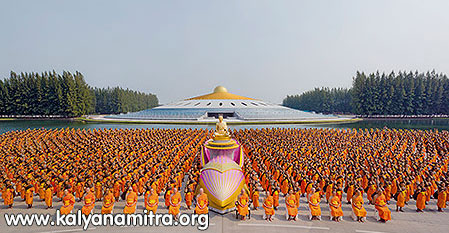
Wat Phra Dhammakaya is the brainchild of Luangpu's top disciple, Khun Yai Chand Khonnokyoong, who Luangpu designated as the one to carry out his mission into the future. It is located on 1,000 acres of land in Pathumthani Province, ten miles from the Bangkok In ternational Airport (Don Muang). Wat Phra Dhammakaya was formally established on Magha Puja Day, February 20, 1970. The main feature of Wat Phra Dhammakaya is the monumental dome-shaped shrine known as "Maha Dhammakaya Cetiya" where 1,000,000 Buddha images are enshrined-300,000 on the exterior dome and 700,000 inside. The compounds surrounding the Cetiya are the gathering ground for Buddhists around the world. Over one million Buddhists gather at the Cetiya during important Buddhist events.
Wat Phra Dhammakaya's motto is: 'Build the temple to be a noble temple; cultivate monks to be true monks; and develop people to be virtuous people'.
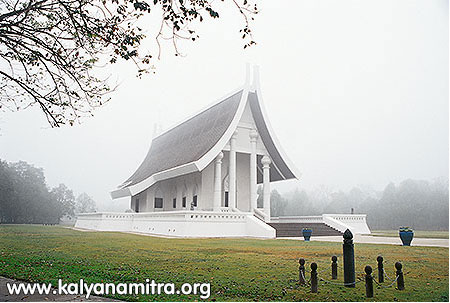
The temple has an amazing beginning befitting the story from a fairy tale. It was started with a mere 3,200 Baht (US$160 in 1970) of Khun Yai Chand's own savings and has grown at an unstoppable rate to become the largest Buddhist temple in the world with over one hundred and sixty branches in thirty-three countries, and still growing.
After Luangpu passed away, Khun Yai Chand continued to propagate the Dhammakaya Knowledge as Luangpu had instructed. Her teaching of Dhammakaya meditation became so popular that the number of students constantly outgrew the available spaces at Wat Paknam. Among Khun Yai's students were two promising young men, Chaiyaboon Suddhipol and Padej Pongsawat, who later became Luangpor Dhammajayo and Luangpor Dattajeevo, Abbot and Vice Abbot of Wat Phra Dhammakaya, respectively. The two are the driving force behind the incredible success of Wat Phra Dhammakaya.
Luangpor Dhammajayo, the Abbot, has devoted his entire life to propagating Buddhism and teaching the Dhammakaya Knowledge to the world, fulfilling the missions of Luangpu Wat Paknam and Khun Yai Chand Khonnokyoong, his teacher. His students have now exceeded one million.
In honor of Luangpu's spiritual attainment and rediscovery of the Dhammakaya Knowledge, Wat Phra Dhammakaya has designated the full moon day of the 10th lunar month of each year as the 'Dhammakaya Master Day'. Every year, hundreds of thousands of the faithful from all parts of the world travel to Wat Phra Dhammakaya to celebrate this historic day, to pay homage to the Buddha and Luangpu, and to practice meditation.